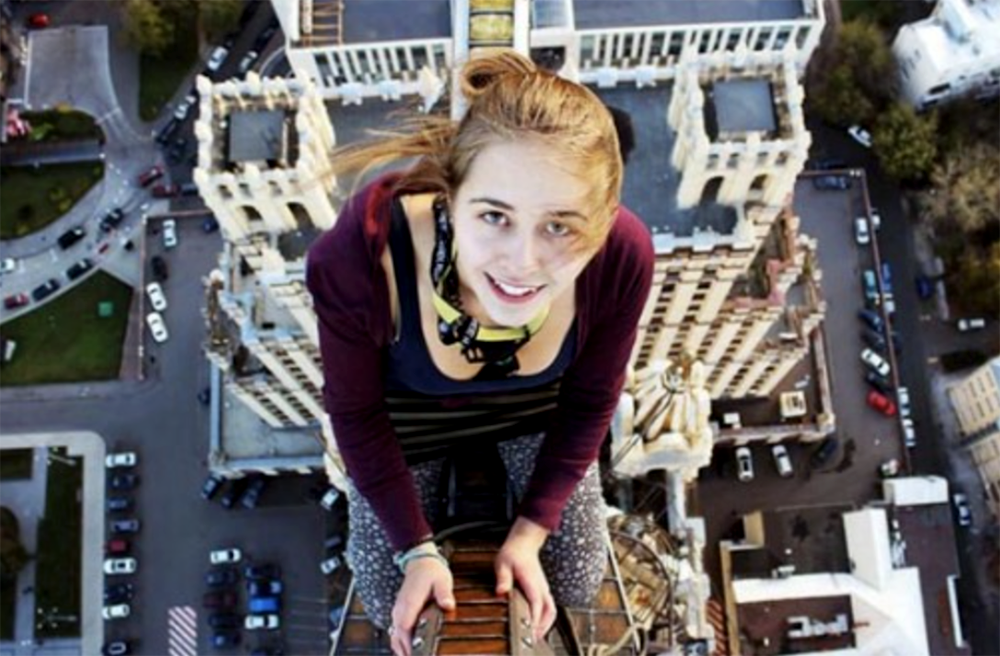
– The Obsession with Dangerous Selfies –
Young people tend to underestimate the consequences of risky behaviors with their phones. Sexting, chatting with strangers… these can have dire consequences. But a growing trend of “dangerous selfies” can have the most severe consequence of all: death. Like Xenia Ignatyeva, who fell to her death minutes after taking this selfie posted above, just a month short of her 18th birthday.
Deadly Selfies
Young people are in constant pursuit of the perfect selfie. For some kids, it means having the right light, hair, smile, and background. For the more adventurous, however, it means capturing a death-defying selfie from the top of their high-rise apartment building, or sneaking up on a wild animal, or getting perilously close to the edge of a canyon. To get a better idea of all the ways young people are putting themselves in harm’s way for a cool selfie, just search for “most dangerous selfies” on YouTube and you will get this video…and others just like it. It’s a big enough phenomenon that a video of deaths has even been compiled.
But you don’t have to go to YouTube; you can just read the newspaper headlines. In July, a British teen visiting Australia fell to his death trying to snap a selfie on the ledge at Cape Solander, a popular whale-watching site. That same month, a 16-year-old Texas girl was accidentally killed when she and her two (male) friends were taking selfies with guns. In September, an 18-year-old boy from Israel slipped and fell to his death at Yosemite National Park while trying to take a selfie atop Nevada Falls. Also in September, a 15-year-old Italian boy fell to his death from the third floor of a shopping center in Milan.
Interestingly, it’s not just teens that are dying while mid-selfie.
- An American woman died in a head-on collision while taking a selfie behind the wheel.
- A man from India died while trying to take a selfie with an injured bear in the wild.
- Another man from India was crushed by a “tusker” (elephant) when trying to grab a selfie.
- So was this guy.
- In fact, so many Indians are dying in elephant-selfie accidents this article had to be written.
According to the Journal of Family Medicine and Primary Care, more than 250 people have died taking selfies since 2011. India, Russia, America, and Pakistan lead the deadly list and unsurprisingly, a whopping majority of the deaths (72%) were males under the age of 30.
But even when the selfie doesn’t result in death, the stunts can still be laden with consequences. Take the “schoolies” from Australia as an example. Every year in late November, these high school graduates in Australia flock to the Gold Coast to celebrate the end of their education. In recent years, taking some sort of daring/racy selfie has become a rite of passage. For instance, guys might hang over the railing of their hotel balconies, while their female friends may choose to flash those on the streets below.
Max Doyle, the Managing Director of Hello Social, knows why kids take these kinds of selfies. “Social media tends to reward outrageous behavior – the wilder your actions, the bigger the bragging rights.” But as we’ve seen, some of those bragging rights are being delivered to young people posthumously.
So, what can parents do to intervene in this growing trend? I suggest three ideas.
- Use the actions of others to help your kids learn inexpensive lessons for themselves. Just like we might do in the wake of a drunk driving accident, or sexting incident, we can lovingly leverage these events to help our kids become aware of the potential dangers of following suite. We don’t have to use gruesome pictures or videos to make our point. There is no need for shock and awe. Simple cause and effect will often do the trick. Read an article when you encounter one, like the many linked in this article, or better yet, go through a book like Jonathan McKee’s The Teen’s Guide to Social Media & Mobile Devices, a book full of stories like these. As tragic as the deaths of young thrill seekers can be, it’s possible for us to lovingly use them to guide our own kids.
- Follow their social media account(s). This is a no-brainer…even in a world where kids don’t dangle themselves off the side of skyscrapers. If your kid has a social media account of any kind – Facebook, Snapchat, Instagram, etc. – you need to be one of their followers. From that vantage point, you can monitor the kinds of pics your teenager is sharing. If you start seeing selfies that look unsafe or irresponsible, you can jump in and have a conversation with them about potential consequences.
- Model safe and responsible behavior. If you want your kids to lead a responsible lifestyle, the most basic requirement is that you do so, as well, in order to provide an example. What does that mean when it comes to selfies? For starters, don’t take them while you’re driving your family around town. And when you visit the Grand Canyon, resist the urge to get within an inch of the ledge. A selfie from 10 feet away from the gorge will always look better than a selfie taken from the emergency room. Bottom line: if you want your kids to take safe selfies, do so yourself!
Remember, the whole point of selfies is to make memories, not archive regrets. Do everything you can to help your kids take safe and responsible selfies they can look back on for years to come.
David R. Smith
David R. Smith is the author of several books including Christianity... It's Like This and speaks to parents and leaders across the U.S. David is a 15-year youth ministry veteran, now a senior pastor, who specializes in sharing the gospel, and equipping others do the same. David provides free resources to anyone who works with teenagers on his website, DavidRSmith.org David resides with his wife and son in Tampa, Florida.




binance Anmeldebonus
March 4, 2025 at 1:01 pmThank you for your sharing. I am worried that I lack creative ideas. It is your article that makes me full of hope. Thank you. But, I have a question, can you help me?
Skapa personligt konto
March 13, 2025 at 8:47 amThanks for sharing. I read many of your blog posts, cool, your blog is very good.
binance
March 14, 2025 at 5:09 pmCan you be more specific about the content of your article? After reading it, I still have some doubts. Hope you can help me.
binance create account
March 15, 2025 at 5:42 pmYour point of view caught my eye and was very interesting. Thanks. I have a question for you.
Jeromesic
March 21, 2025 at 2:12 pmalo 789: alo789 dang nh?p – alo 789 dang nh?p
MonteMap
March 24, 2025 at 5:42 ammexican pharmacy online reliable mexican pharmacies mexican drug stores online
Georgetom
March 24, 2025 at 3:47 pmIndia Med Fast: IndiaMedFast – cheapest online pharmacy india
WillisLutle
March 24, 2025 at 7:28 pmhttps://indiamedfast.shop/# IndiaMedFast.com
Arthurwef
March 24, 2025 at 9:41 pmhttps://indiamedfast.shop/# online medicine shopping in india
northwest canadian pharmacy
WillisLutle
March 25, 2025 at 2:13 amhttp://interpharmonline.com/# canadian drug pharmacy
WillisLutle
March 25, 2025 at 8:55 amhttps://mexicanpharminter.shop/# buying from online mexican pharmacy
Howardslutt
March 25, 2025 at 10:56 amcanadian drug stores: Pharmacies in Canada that ship to the US – canadian pharmacy online
WillisLutle
March 25, 2025 at 3:46 pmhttps://indiamedfast.shop/# IndiaMedFast
Arthurwef
March 25, 2025 at 5:46 pmhttps://interpharmonline.com/# canada discount pharmacy
medication canadian pharmacy
Howardslutt
March 25, 2025 at 8:22 pmcanadian pharmacy oxycodone: online canadian pharmacy no prescription – certified canadian international pharmacy
DwayneLah
March 26, 2025 at 1:23 amTadalafilEasyBuy.com TadalafilEasyBuy.com cialis without a doctor prescription
Williamben
March 26, 2025 at 4:57 amTadalafilEasyBuy.com: cialis without a doctor prescription – cialis without a doctor prescription
Williamben
March 26, 2025 at 12:05 pmTadalafilEasyBuy.com: cialis without a doctor prescription – buy cialis pill
Williamben
March 26, 2025 at 7:27 pmTadalafilEasyBuy.com: Generic Tadalafil 20mg price – TadalafilEasyBuy.com
TerryErose
March 26, 2025 at 10:34 pmhttp://generic100mgeasy.com/# Generic 100mg Easy
TerryErose
March 27, 2025 at 5:39 amhttps://tadalafileasybuy.shop/# cialis without a doctor prescription
TerryErose
March 27, 2025 at 12:24 pmhttps://kamagrakopen.pro/# kamagra kopen nederland
KennethLus
March 27, 2025 at 1:56 pmhttps://tadalafileasybuy.com/# Cialis 20mg price
TerryErose
March 27, 2025 at 6:48 pmhttps://tadalafileasybuy.com/# TadalafilEasyBuy.com
KennethLus
March 27, 2025 at 8:23 pmhttps://kamagrakopen.pro/# Kamagra Kopen Online
KennethLus
March 28, 2025 at 2:47 amhttp://generic100mgeasy.com/# Generic100mgEasy
Williamben
March 28, 2025 at 6:31 amkamagra pillen kopen: Kamagra – KamagraKopen.pro
DwayneLah
March 28, 2025 at 7:35 amKamagra Kopen Online Kamagra Kopen KamagraKopen.pro
KennethLus
March 28, 2025 at 8:59 amhttps://generic100mgeasy.com/# Generic100mgEasy
TerryErose
March 28, 2025 at 1:29 pmhttps://tadalafileasybuy.shop/# Tadalafil Easy Buy
Williamben
March 28, 2025 at 2:19 pmTadalafilEasyBuy.com: TadalafilEasyBuy.com – TadalafilEasyBuy.com
KennethLus
March 28, 2025 at 3:05 pmhttps://generic100mgeasy.shop/# Generic 100mg Easy
DwayneLah
March 28, 2025 at 6:37 pmGeneric100mgEasy Generic100mgEasy Generic100mgEasy
Jamesmig
March 29, 2025 at 2:34 amпинап казино – пин ап зеркало
Williampaics
March 29, 2025 at 7:13 amпин ап вход – пин ап казино официальный сайт
DwayneLah
March 29, 2025 at 8:59 amViagra tablet online Generic100mgEasy Generic 100mg Easy
Williampaics
March 29, 2025 at 1:26 pmпин ап казино официальный сайт – пин ап казино
Williampaics
March 29, 2025 at 7:34 pmpinup 2025 – пин ап казино зеркало
Williampaics
March 30, 2025 at 7:52 amпин ап зеркало – пинап казино
DwayneLah
March 30, 2025 at 10:05 amviagra canada Generic 100mg Easy Generic 100mg Easy
Jamesmig
March 30, 2025 at 10:42 amпин ап вход – pinup 2025
Williampaics
March 30, 2025 at 2:20 pmпин ап казино официальный сайт – пин ап казино официальный сайт
Jamesmig
March 30, 2025 at 5:05 pmпин ап – пин ап казино зеркало
DwayneLah
March 30, 2025 at 9:38 pmKamagra Kopen Kamagra Kopen Online kamagra jelly kopen
MichaelTwedO
March 31, 2025 at 4:53 pmKamagra Original: Kamagra online bestellen – kamagra
MichaelTwedO
March 31, 2025 at 11:28 pmKamagra kaufen: Kamagra online bestellen – Kamagra kaufen
DerekUnoto
April 1, 2025 at 6:30 amKamagra Oral Jelly: Kamagra Oral Jelly kaufen – Kamagra Oral Jelly
MichaelTwedO
April 1, 2025 at 6:32 amKamagra kaufen: Kamagra Original – Kamagra Oral Jelly kaufen
MichaelTwedO
April 1, 2025 at 1:35 pmOnline apotheek Nederland zonder recept: de online drogist kortingscode – online apotheek
MichaelTwedO
April 1, 2025 at 8:47 pmBeste online drogist: ApotheekMax – Online apotheek Nederland zonder recept
MichaelTwedO
April 2, 2025 at 3:57 amApotek hemleverans recept: Apotek hemleverans recept – Apotek hemleverans idag
MichaelTwedO
April 2, 2025 at 11:34 amde online drogist kortingscode: ApotheekMax – Apotheek online bestellen
LouisCig
April 2, 2025 at 11:34 amhttps://apotekonlinerecept.shop/# Apoteket online
Malcolmnag
April 2, 2025 at 1:34 pmapotek pa nett Apoteket online Apotek hemleverans recept
DerekUnoto
April 2, 2025 at 5:44 pmBetrouwbare online apotheek zonder recept: Online apotheek Nederland met recept – ApotheekMax
MichaelTwedO
April 2, 2025 at 7:02 pmKamagra kaufen: Kamagra Gel – Kamagra kaufen ohne Rezept
Malcolmnag
April 3, 2025 at 12:52 amapotek online recept Apotek hemleverans idag apotek pa nett
MichaelTwedO
April 3, 2025 at 2:21 amKamagra Oral Jelly kaufen: Kamagra kaufen – Kamagra Oral Jelly
Matthewexogs
April 3, 2025 at 8:42 amhttp://wwwindiapharm.com/# www india pharm
RobertFem
April 3, 2025 at 11:03 amonline canadian pharmacy GoCanadaPharm canada pharmacy online legit
Matthewexogs
April 3, 2025 at 3:20 pmhttps://agbmexicopharm.com/# Agb Mexico Pharm
ChesterWob
April 3, 2025 at 6:07 pmpharmacy website india: www india pharm – www india pharm
Matthewexogs
April 3, 2025 at 9:49 pmhttp://wwwindiapharm.com/# п»їlegitimate online pharmacies india
Trentswozy
April 4, 2025 at 6:08 amcanadian pharmacy 365: go canada pharm – buy prescription drugs from canada cheap
Matthewexogs
April 4, 2025 at 1:24 pmhttp://agbmexicopharm.com/# buying from online mexican pharmacy
ChesterWob
April 4, 2025 at 3:46 pmAgb Mexico Pharm: buying prescription drugs in mexico – mexico drug stores pharmacies
EdwinHug
April 4, 2025 at 5:46 pmmexican rx online: mexico pharmacies prescription drugs – buying prescription drugs in mexico
Matthewexogs
April 5, 2025 at 4:13 amhttp://agbmexicopharm.com/# Agb Mexico Pharm
RobertFem
April 5, 2025 at 8:56 amwww india pharm Online medicine order india pharmacy
Matthewexogs
April 5, 2025 at 11:39 amhttp://gocanadapharm.com/# best canadian pharmacy to order from
EdwinHug
April 5, 2025 at 3:14 pmwww india pharm: mail order pharmacy india – indianpharmacy com
Matthewexogs
April 5, 2025 at 6:58 pmhttps://agbmexicopharm.shop/# buying from online mexican pharmacy
RobertFem
April 5, 2025 at 8:23 pmwww india pharm india pharmacy mail order indian pharmacies safe
Richardboobe
April 6, 2025 at 1:58 amhttps://amonlinepharm.shop/# AmOnlinePharm
Michaelrug
April 6, 2025 at 5:27 ambuy lisinopril 2.5 mg online: Lisin Express – where to buy lisinopril online
Michaelrug
April 6, 2025 at 10:32 ambuy prednisone without rx: Pred Pharm Net – where to buy prednisone 20mg
Brianfliny
April 7, 2025 at 1:17 amzithromax 250 mg ZithPharmOnline can you buy zithromax online
Richardboobe
April 7, 2025 at 2:31 amhttps://amonlinepharm.com/# amoxicillin 500mg without prescription
Danielcrync
April 7, 2025 at 4:07 amAmOnlinePharm: AmOnlinePharm – AmOnlinePharm
Richardboobe
April 7, 2025 at 10:19 amhttp://amonlinepharm.com/# where can i buy amoxocillin
Richardboobe
April 7, 2025 at 5:46 pmhttps://clomfastpharm.com/# Clom Fast Pharm
Richardboobe
April 8, 2025 at 1:11 amhttps://predpharmnet.com/# prednisone otc uk
Michaelrug
April 8, 2025 at 1:22 amClom Fast Pharm: cost of generic clomid no prescription – where buy generic clomid prices
Richardboobe
April 8, 2025 at 9:33 amhttps://amonlinepharm.shop/# AmOnlinePharm
Danielcrync
April 8, 2025 at 10:15 amClom Fast Pharm: can i order cheap clomid pills – Clom Fast Pharm
Brianfliny
April 8, 2025 at 3:34 pmAmOnlinePharm AmOnlinePharm AmOnlinePharm
LanceMup
April 8, 2025 at 3:43 pmAmOnlinePharm: AmOnlinePharm – AmOnlinePharm
Richardboobe
April 8, 2025 at 5:29 pmhttps://amonlinepharm.com/# AmOnlinePharm
RobertVow
April 9, 2025 at 6:08 ammobil bahis siteleri: casibom 1st – date sitesi casibom1st.com
Davidtop
April 9, 2025 at 2:24 pmhttp://casinositeleri1st.com/# deneme bonusu veren siteler
GarrettEmuro
April 9, 2025 at 11:25 pmcasino siteleri lisansl? casino siteleri guvenilir casino siteleri casinositeleri1st.shop
RobertVow
April 10, 2025 at 3:46 amgГјvenilir illegal bahis siteleri: casibom – 300 tl bonus veren bahis sitesi casibom1st.com
GarrettEmuro
April 10, 2025 at 11:29 ambГјtГјn oyun siteleri casibom 1st bet siteler casibom1st.shop
GarrettEmuro
April 10, 2025 at 11:36 pmcasino siteleri 2025 guvenilir casino siteleri casino siteleri 2025 casinositeleri1st.shop
Davidtop
April 11, 2025 at 12:06 amhttps://casibom1st.com/# deneme bonusu bahis siteleri
Bradysalse
April 11, 2025 at 3:13 amsweet bonanza giris: sweet bonanza – sweet bonanza sweetbonanza1st.shop
Bradysalse
April 11, 2025 at 10:20 amonline casino turkey: guvenilir casino siteleri – bonus veren bahis siteleri yasal casinositeleri1st.com
GarrettEmuro
April 11, 2025 at 11:52 amsweet bonanza sweet bonanza siteleri sweet bonanza yorumlar sweetbonanza1st.com
Davidtop
April 11, 2025 at 1:29 pmhttp://sweetbonanza1st.com/# sweet bonanza demo
RobertVow
April 11, 2025 at 7:58 pmoyun siteleri: slot casino siteleri – deneme bonusu veren siteler casinositeleri1st.com
Steveaccup
April 12, 2025 at 12:25 amhttps://usmexpharm.shop/# buying prescription drugs in mexico
Randyepito
April 12, 2025 at 6:33 pmUs Mex Pharm certified Mexican pharmacy mexican pharmacy
MicahArick
April 12, 2025 at 11:06 pmUSMexPharm: certified Mexican pharmacy – Us Mex Pharm
Steveaccup
April 13, 2025 at 12:37 amhttps://usmexpharm.shop/# certified Mexican pharmacy
Steveaccup
April 13, 2025 at 8:10 amhttp://usmexpharm.com/# Mexican pharmacy ship to USA
Cletusbrode
April 13, 2025 at 8:57 amcertified Mexican pharmacy: USMexPharm – UsMex Pharm
Steveaccup
April 13, 2025 at 3:44 pmhttps://usmexpharm.com/# Us Mex Pharm
MicahArick
April 13, 2025 at 9:44 pmmexico drug stores pharmacies: mexican pharmacy – certified Mexican pharmacy
Carltondeaps
April 13, 2025 at 11:43 pmhttps://usaindiapharm.com/# UsaIndiaPharm
Georgecip
April 14, 2025 at 4:33 amonline shopping pharmacy india: buy prescription drugs from india – UsaIndiaPharm
Georgecip
April 14, 2025 at 10:51 amonline pharmacy india: pharmacy website india – india online pharmacy
Carltondeaps
April 14, 2025 at 12:07 pmhttps://usaindiapharm.shop/# UsaIndiaPharm
Georgecip
April 14, 2025 at 4:54 pmUSA India Pharm: USA India Pharm – USA India Pharm
Carltondeaps
April 14, 2025 at 6:05 pmhttp://usaindiapharm.com/# UsaIndiaPharm
Frankciz
April 15, 2025 at 4:23 amUsaIndiaPharm: п»їlegitimate online pharmacies india – USA India Pharm
Georgecip
April 15, 2025 at 6:45 amOnline medicine home delivery: USA India Pharm – UsaIndiaPharm
Carltondeaps
April 15, 2025 at 8:00 amhttps://usaindiapharm.com/# reputable indian online pharmacy
Carltondeaps
April 15, 2025 at 10:02 pmhttp://usaindiapharm.com/# online shopping pharmacy india
DavidTrusa
April 16, 2025 at 2:30 amUSA India Pharm UsaIndiaPharm USA India Pharm
Georgecip
April 16, 2025 at 3:57 amUsaIndiaPharm: indian pharmacy paypal – indian pharmacy paypal
Carltondeaps
April 16, 2025 at 5:10 amhttp://usaindiapharm.com/# UsaIndiaPharm
Carltondeaps
April 16, 2025 at 12:33 pmhttps://usaindiapharm.com/# UsaIndiaPharm
Carltondeaps
April 16, 2025 at 7:55 pmhttps://usaindiapharm.com/# USA India Pharm
Carltondeaps
April 17, 2025 at 3:20 amhttp://usaindiapharm.com/# USA India Pharm
TimothyLaw
April 17, 2025 at 11:12 amUSACanadaPharm canadian pharmacy online canadian online pharmacy
Albertzoobe
April 17, 2025 at 3:48 pmhttps://usacanadapharm.shop/# usa canada pharm
Albertzoobe
April 17, 2025 at 9:28 pmhttps://usacanadapharm.com/# best canadian pharmacy to order from
Albertzoobe
April 18, 2025 at 4:30 amhttp://usacanadapharm.com/# canadian drugs pharmacy
Albertzoobe
April 18, 2025 at 6:28 pmhttp://usacanadapharm.com/# pharmacy canadian
Albertzoobe
April 19, 2025 at 1:26 amhttps://usacanadapharm.shop/# onlinecanadianpharmacy 24
EverettSweep
April 19, 2025 at 3:43 ambuy prescription drugs from canada cheap https://usacanadapharm.shop/# USACanadaPharm
legal canadian pharmacy online
TimothyLaw
April 19, 2025 at 7:00 amUSACanadaPharm canadian pharmacy 365 safe canadian pharmacy
Albertzoobe
April 19, 2025 at 8:29 amhttps://usacanadapharm.com/# buying from canadian pharmacies
Albertzoobe
April 19, 2025 at 3:27 pmhttps://usacanadapharm.com/# USACanadaPharm
TimothyLaw
April 19, 2025 at 7:05 pmusa canada pharm usa canada pharm certified canadian international pharmacy
DwightExpaw
April 19, 2025 at 7:15 pmed meds online canada: canadian pharmacy in canada – the canadian pharmacy
Albertzoobe
April 19, 2025 at 10:42 pmhttp://usacanadapharm.com/# usa canada pharm
Alberturiny
April 20, 2025 at 6:37 amhttps://olympecasino.pro/# casino olympe
WilliamCib
April 20, 2025 at 6:48 amolympe casino: olympe casino cresus – olympe
Ronaldaddek
April 20, 2025 at 7:24 amolympe casino avis olympe casino
VictorDooky
April 20, 2025 at 7:52 amolympe casino: olympe casino cresus – olympe casino avis
Alberturiny
April 23, 2025 at 2:45 pmhttps://olympecasino.pro/# casino olympe
VictorDooky
April 23, 2025 at 4:49 pmolympe casino avis: olympe casino cresus – olympe casino cresus
Peterkal
April 23, 2025 at 10:31 pmPharmacie en ligne Cialis sans ordonnance Tadalafil 20 mg prix en pharmacie Cialis sans ordonnance 24h tadalmed.com
Billiemug
April 23, 2025 at 10:31 pmpharmacie en ligne sans ordonnance: pharmacies en ligne certifiГ©es – pharmacie en ligne avec ordonnance pharmafst.com
Robertavaiz
April 23, 2025 at 11:22 pmhttp://tadalmed.com/# Tadalafil sans ordonnance en ligne
Billiemug
April 24, 2025 at 1:34 amcialis prix: Tadalafil 20 mg prix en pharmacie – Achat Cialis en ligne fiable tadalmed.shop
Peterkal
April 24, 2025 at 1:50 ampharmacie en ligne pas cher Pharmacies en ligne certifiees pharmacie en ligne sans ordonnance pharmafst.shop
Robertavaiz
April 24, 2025 at 2:26 amhttps://pharmafst.shop/# pharmacie en ligne france livraison belgique
Billiemug
April 24, 2025 at 4:31 amп»їpharmacie en ligne france: Pharmacie en ligne France – trouver un mГ©dicament en pharmacie pharmafst.com
Peterkal
April 24, 2025 at 5:08 amvente de mГ©dicament en ligne Medicaments en ligne livres en 24h pharmacie en ligne pharmafst.shop
Robertavaiz
April 24, 2025 at 5:28 amhttps://kamagraprix.shop/# kamagra gel
Billiemug
April 24, 2025 at 7:38 amTadalafil 20 mg prix en pharmacie: Pharmacie en ligne Cialis sans ordonnance – cialis generique tadalmed.shop
Robertavaiz
April 24, 2025 at 8:35 amhttps://tadalmed.shop/# cialis prix
Peterkal
April 24, 2025 at 8:37 amKamagra Oral Jelly pas cher Kamagra Commander maintenant Achetez vos kamagra medicaments
Billiemug
April 24, 2025 at 10:39 amKamagra Commander maintenant: kamagra en ligne – kamagra pas cher
Robertavaiz
April 24, 2025 at 11:38 amhttps://pharmafst.com/# pharmacie en ligne avec ordonnance
Peterkal
April 24, 2025 at 11:59 ampharmacie en ligne avec ordonnance Meilleure pharmacie en ligne pharmacie en ligne sans ordonnance pharmafst.shop
Billiemug
April 24, 2025 at 1:38 pmAcheter Viagra Cialis sans ordonnance: Tadalafil 20 mg prix en pharmacie – Tadalafil achat en ligne tadalmed.shop
Robertavaiz
April 24, 2025 at 2:39 pmhttps://tadalmed.com/# Acheter Viagra Cialis sans ordonnance
Peterkal
April 24, 2025 at 3:25 pmKamagra Commander maintenant kamagra en ligne kamagra 100mg prix
Billiemug
April 24, 2025 at 4:42 pmpharmacies en ligne certifiГ©es: Meilleure pharmacie en ligne – pharmacie en ligne sans ordonnance pharmafst.com
Robertavaiz
April 24, 2025 at 5:46 pmhttp://kamagraprix.com/# Acheter Kamagra site fiable
Peterkal
April 24, 2025 at 6:48 pmAcheter Viagra Cialis sans ordonnance Pharmacie en ligne Cialis sans ordonnance cialis generique tadalmed.com
Billiemug
April 24, 2025 at 7:46 pmAchat mГ©dicament en ligne fiable: pharmacie en ligne sans ordonnance – pharmacie en ligne france livraison belgique pharmafst.com
Robertavaiz
April 24, 2025 at 9:00 pmhttps://pharmafst.com/# Pharmacie Internationale en ligne
Billiemug
April 24, 2025 at 11:45 pmPharmacie en ligne livraison Europe: pharmacie en ligne fiable – Achat mГ©dicament en ligne fiable pharmafst.com
Bernardsed
April 25, 2025 at 1:07 amPharmacie en ligne Cialis sans ordonnance: Cialis sans ordonnance 24h – Acheter Viagra Cialis sans ordonnance tadalmed.shop
Robertavaiz
April 25, 2025 at 2:30 amhttp://kamagraprix.com/# Achetez vos kamagra medicaments
Bradleydok
April 26, 2025 at 5:15 amcialis prix: Achat Cialis en ligne fiable – cialis prix tadalmed.shop
ElmerBar
May 2, 2025 at 3:35 amпин ап казино: пин ап казино – пин ап вход
ElmerBar
May 7, 2025 at 7:34 amvavada: vavada – vavada вход